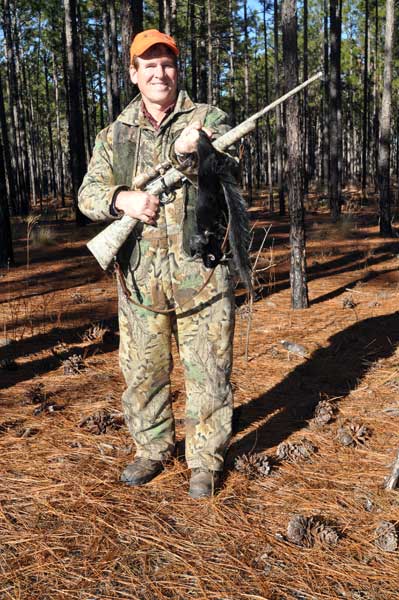 Editor's Note: Mike Marsh took this black phase fox squirrel at Bladen Lakes Game Land at 12:30 p.m. Fox squirrels move throughout the day and are typically more active in late morning and early afternoon that gray squirrels. The rifle is a Savage M93 in camo finish with AccuTrigger. It is extremely accurate. The bullet was a Winchester 20 grain game bullet. Although it is a better choice for shooting squirrels with less destruction than the polymer tipped .17HMR ammo, the longer ogive and dimple point causes occasional feeding problems when the edge of the point strikes the lower part of the chamber in both of my .17 HMR rifles. Bending the ears on the magazines and bending the magazine catches has improved, but not eliminated these problems. An idea for rifles that don't feed the 20 grainers reliably is loading the Game Bullet first, then following with the .17-grain polymer tips in the magazine. My rifles shoot some brands to identical points of impact.
Editor's Note: Mike Marsh took this black phase fox squirrel at Bladen Lakes Game Land at 12:30 p.m. Fox squirrels move throughout the day and are typically more active in late morning and early afternoon that gray squirrels. The rifle is a Savage M93 in camo finish with AccuTrigger. It is extremely accurate. The bullet was a Winchester 20 grain game bullet. Although it is a better choice for shooting squirrels with less destruction than the polymer tipped .17HMR ammo, the longer ogive and dimple point causes occasional feeding problems when the edge of the point strikes the lower part of the chamber in both of my .17 HMR rifles. Bending the ears on the magazines and bending the magazine catches has improved, but not eliminated these problems. An idea for rifles that don't feed the 20 grainers reliably is loading the Game Bullet first, then following with the .17-grain polymer tips in the magazine. My rifles shoot some brands to identical points of impact.
I've hunted fox squirrels for years. I once shot a silver phase fox squirrel back when Sutton Lake game land still had longleaf pines and the fox squirrels were abundant. Now, the area has been logged and is no longer a game land, except around the fringes of the lake with a bow-only area south of the power plant.
The black phase is not really rare, but they are less common than other phases.
I was hunting at Bladen Lakes State Forest, but other game lands that have them include Croatan and Sandhills. I don't know why the SC WMA's don't allow hunting fox squirrels, but I have seen many black phase fox squirrels there. Pee Dee NWR does not allow them to be hunted, but I have see them there as well.
A friend mounted the silver fox squirrel years ago. It was all silver and had blue eyes and I have never seen another one. I wonder if it had grown so old that it had simply "gone gray" from its former coloration.
My black phase fox squirrel was a female and I will have her mounted. I had been speaking to Andy Waldrop, the local NCWRC officer for about an hour. I headed for an area that has traditionally had lots of fox squirrel nests and watched them. While I have taken many gray phase fox squirrels, I had not seen a black phase in this area.
I sat on folding chair for less than five minutes, looking at a limb that seemed perfect for sunning on a chilly day. A dark shadow slunk along below some live oak leaves, making its way to the sunning limb.
It was a black phase fox squirrel!
I aligned the crosshairs of a 3x9x32 Simmons .22 MAG scope. With its adjustable objective and ocular, the sight image was so clear I could see individual hairs at 50 yards. The shot seemed too easy for a hunt that took years to complete.
I suggest that anyone who wants to take a black phase fox squirrel NOT shoot the other color phases during a hunt. The limit of one per day surely delayed my taking of the black phase. But for me, any shot at a fox squirrel had been just too tempting to pass up. It typically takes two days of hunting to get a shot at a fox squirrel in good habitat. Go deer hunting and they appear as common as flies. Go fox squirrel hunting, and they seem to disappear.
